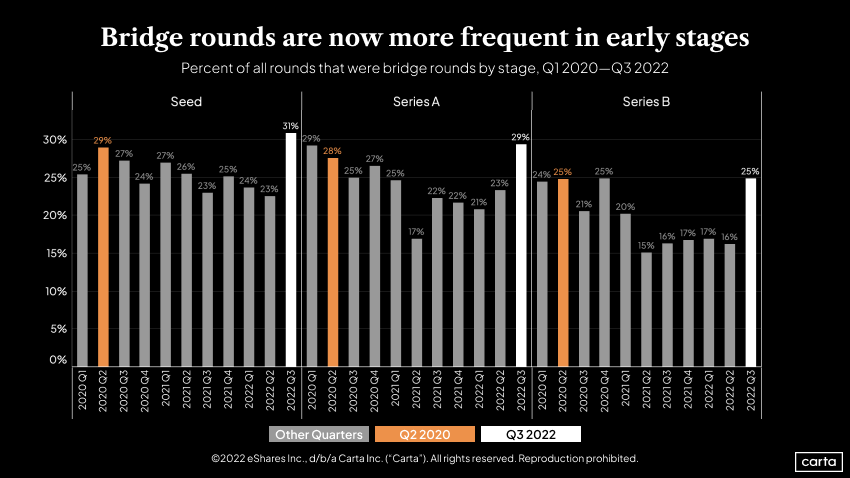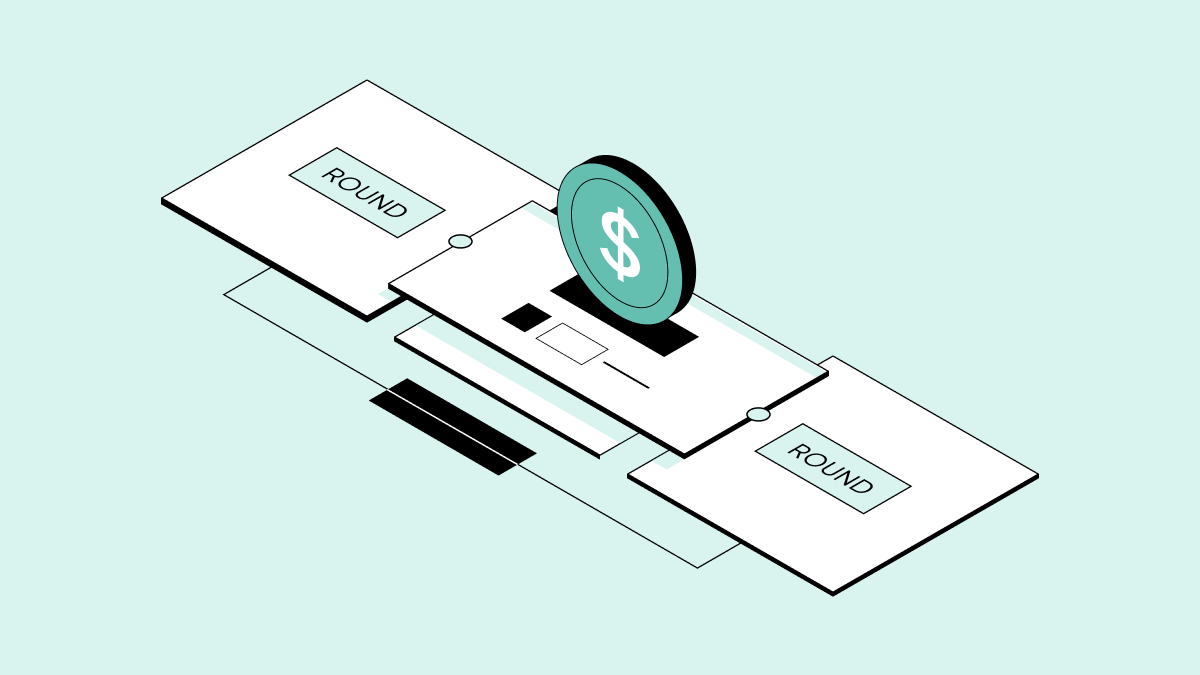As this year’s slowdown in venture capital continued through Q3, VCs increasingly used bridge rounds to keep their portfolio companies afloat—or to position them for a stronger rebound when dealmaking picks up.
Bridge rounds are unpriced financing rounds that occur between primary financings. Typically, a lead investor in the most recent priced round leads the bridge round.
In August, Carta reported an uptick in late-stage bridge round activity: From Q1 to Q2, Series D and Series E+ companies saw a significant rise in the percentage of fundraising rounds that were bridge rounds (+7 and +14 percentage points, respectively). Amid the volatility and contraction that plagued the public markets throughout the first half of the year, private companies at these later stages saw their valuations drop. Many may have turned to bridge rounds to wait out the unfavorable macro climate, with the hope of raising their next round or making a public exit in a bull market.

Early-stage startups were less affected as of the close of Q2, with the percentage of Series A bridge rounds ticking up 3% quarter over quarter and seed stage remaining flat. Series B saw a slight decrease in bridge rounds in Q2, with the percentage of financings that were bridge rounds falling by 1 percentage point.
But in Q3, traditional dealmaking slowed across stages, and the length of time between early-stage rounds increased. The trend toward bridge rounds also extended beyond late-stage startups into the earlier stages: Companies at the seed, Series A and Series B stages all saw a rise in the number of unpriced rounds relative to total financings in Q3.
Why early-stage bridge rounds are increasing
The jump in bridge rounds for early-stage startups comes after they initially faced a more favorable capital raising environment than late-stage private companies in early 2022: When later-stage dealmaking began to falter in response to economic uncertainties, early-stage dealmaking continued strong through the first months of the year (albeit at a slower pace than in 2021) because early-stage deals are less impacted when the public markets struggle. But as the venture funding downturn continued, even early-stage companies were unable to avoid the consequences of decreased fundraising activity and falling valuations.
Tubergen sees opportunity for bridge investors
Startups almost always prefer a bridge round before they agree to a down or flat round. VCs, on the other hand, have often shied away from bridge rounds, for fear of throwing good money after bad. This reluctance made sense in a robust funding environment, when dollars and rounds raised were both on the rise. But it’s giving way amid 2022’s retreat in venture funding.
Luke Tubergen, a general partner at the Ember Fund, says traditional VC firms have shifted their focus to doubling down on portfolio companies rather than seeking new opportunities, with many taking a “wait-and-see” approach until there’s more certainty about whether the U.S. economy enters a recession.
Founded in 2015, Ember Fund specializes in hybrid bridge-financing deals for early-stage consumer companies. Unlike in a typical bridge round, where the financing is led by one of the startup’s existing investors, Ember often first invests between primary rounds, to support companies in need of capital. Ember focuses on companies generating revenue (usually between $2 million and $20 million) in part because brands that sell products quickly often need more inventory but don’t want to take out a traditional bank loan or ask their original investors for more money.
Ember offers these companies a debt-equity investment structure: The firm pays cash for a tranche of preferred shares and receives between 1% and 4% of the company’s equity. Ember also charges a financing fee of around 7.5% for loans starting at $250,000. Companies can then use the capital to buy up inventory until their next priced round. Ember’s bridge financing is meant to last anywhere between four months to two years and comes with a team of advisors from the Ember Lab. Often, Ember will make a follow-on investment as soon as the portfolio company pays back any loans.
“We’ve found that [our strategy] really has positioned us well for a time like this,” Tubergen says, referring to 2022’s combination of strong consumer demand and decreased venture funding. In October, retail sales ticked up 1.3%, according to the U.S. Census Bureau, surpassing analyst forecasts and defying the Federal Reserve’s attempts to tamp down inflation.
“I have seen a lot of companies that are looking for cash,” Tubergen explains, “And they’re looking to operate their business and grow their business, but are not wanting to put a valuation on it and test the true VC market.” In other words, they’re extending their runways to adapt to higher prices and the changing capital-raising environment.
Some investors still resist bridge financings
Although economic forces are driving the increase in bridge rounds, some investors still view them as a last resort.
Edison Partners COO Kelly Ford Buckley says her growth investment firm hasn’t used bridge rounds to bail out portfolio companies. Instead, Edison has continued to seek new investment opportunities at lower valuations. Based in Princeton, N.J., the firm began as a VC firm but now focuses on growth investments for middle-market tech companies.
Before pursuing a bridge round, Ford Buckley believes that founders should first focus on building a sustainable business. “The bridge isn’t necessarily gonna achieve that and get them on that right path,” she warns. But that doesn’t mean they should be ruled out if necessary: “In this environment, you have to use the levers you’ve got,” she says.
Ford Buckley says founders should also weigh whether it’s better for them to raise a down or flat round. Founders who do choose a bridge round should use them to invest in marketing and product improvements, so they are better positioned to justify their valuation when they go to raise capital.
In the meantime, Ford Buckley is worried about the future of late-stage tech companies that haven’t managed their money without considering the possibility of a downturn. For those founders, it may be time to pull back on revenue growth projections and focus instead on sustainability.
“The most important thing you can do is extend your runway and conserve cash,” Ford Buckley says. “If you have to do it, you turn to profitability and [don’t] grow as fast.”
Learn more
Get weekly insights in your inbox
The Data Minute is Carta’s weekly newsletter for data insights into trends in venture capital. Sign up here:
